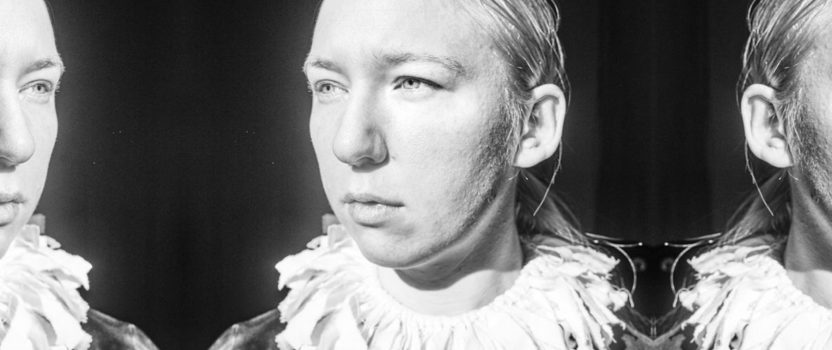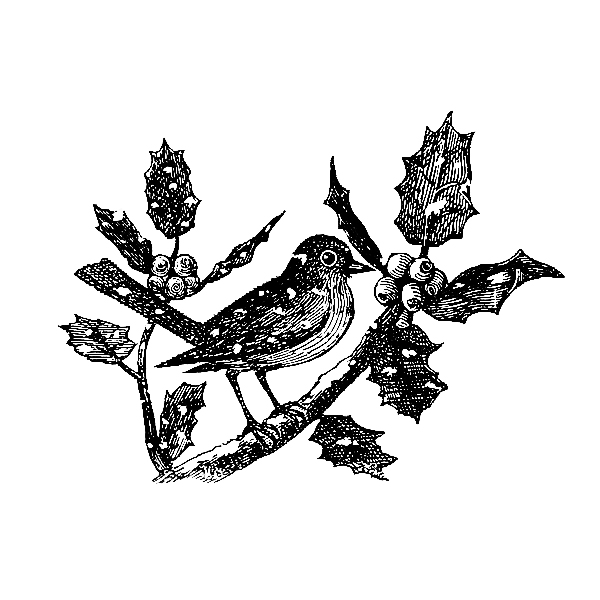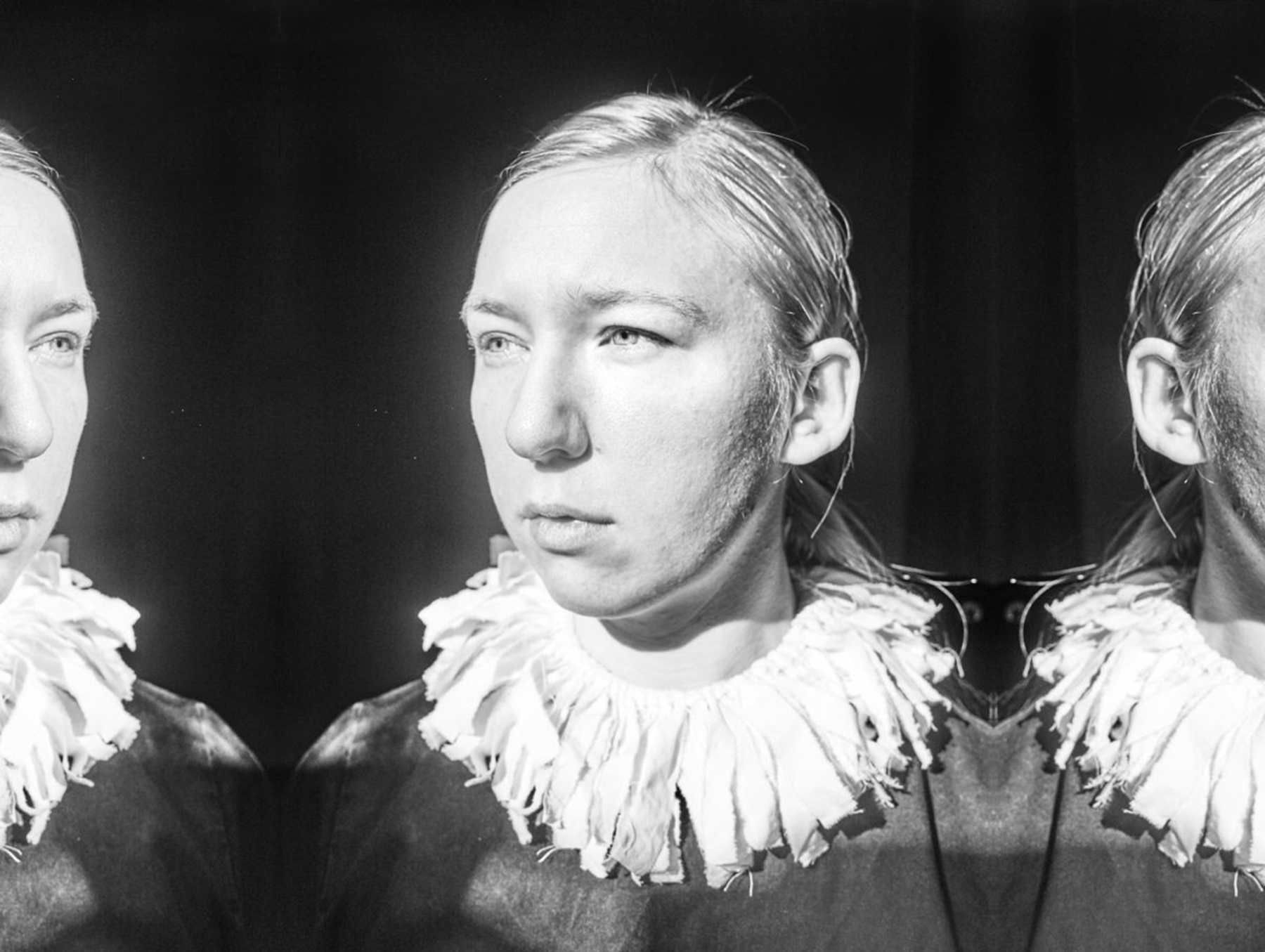The Swedish Rage: A conversation with Fågelle
Blending musical genres that are complete opposites is always an intriguing notion, but a very risky one as well. More often than not, the results are less than desirable, but when it does work out, it can be beyond wondrous. A perfect example of this wondrous outcome is Fågelle, a project created by Swedish singer and songwriter Klara Andersson. Emerging out of the nordic experimental music scene, Fågelle is a wild collision of lyrical beauty and unhinged, raw expression, creating music where layers of noise meet pop melodies in an exploration of rhythms and the subject of power. Her sound world consists of everything from field recordings to roaring guitars and tormented synthesizers, and has been aptly described as “a soft punch in the face”.
On January 27th, Fågelle released her sophomore record, Den svenska vreden, a tremendous work that explores feelings of isolation and anger in collage-like soundscapes made with twisted field recordings, mobile memories, digital trash, dark electronics and howling choirs, while moving between harmony and noise, juxtaposing lyrical songwriting and disruptive experiments to reflect the whole in all their facets. A few days before its release, we spoke with Klara Andersson about her musical upbringing, the origins of Fågelle and how the creation of Den svenska vreden and a move to Germany helped her in dealing with loneliness, anger and frustration.
How was life in Sweden growing up and what was your first contact with music?
I feel like music has always been around for me. I don’t come from a home of professional musicians, but we were always listening to music, playing the piano and guitars, singing harmonies with my mum, and so on. So, it’s always been around and I feel like it was a very supportive environment in general. We have this very good art and cultural public school system where anybody can go after school and learn to play instruments. They just pay a small fee, it’s subsidized and it gives everybody the chance to learn the craft, to try it out and I think that creates a lot of opportunities for people to explore what they like, to become good at the instruments and making music. I generally thought it was a very supportive environment.
“I feel like music has always been around for me. I don’t come from a home of professional musicians, but we were always listening to music, playing the piano and guitars, singing harmonies with my mum, and so on. So, it’s always been around and I feel like it was a very supportive environment in general.”
Was there a specific instrument that you latched on to early on?
When I was really small, I just played the piano; I just sat at the piano and couldn’t really play. I’ve always been a person that does everything by ear and for a long time, I didn’t really want to learn properly and nobody forced me. So, I was sort of doing it in my own way, which I still do. But then, when I was like ten or eleven, my mum taught me three chords on the guitar and then, I just continued playing the guitar by myself. I’ve had lessons and I’ve had great teachers, but it never really appealed to me doing it in the sort of traditional way, I wasn’t disciplined enough for that.
You preferred doing things your own way, rather than pick up lessons and learn how to play music.
Yeah, very self-absorbed, really. [laughs] Because for a long time, I felt like the guitar was a way for me to play my songs by myself, this is a tool for me to sing the songs that I write. I wasn’t really interested in it, in its own right, for a long time.
When did you start becoming interested in composing music?
Really early on, I don’t know how old I was, but it was always really interesting to me. I have a bunch of bad pop songs from when I was twelve or thirteen. It’s just been something that I have been doing all the time, but in different ways. So, it was like singing and songwriting for a long time, and then, that became kind of boring to me. I had this band and we were playing my songs, but then, I started getting more into experimental music and I was part of this workshop in my home city with Mats Gustafsson and his free jazz band The Thing, and it blew my mind. And I was like, okay, I need to never write a song again, I just want to make noises. [laughs] And then, I did that for a while, I studied sound art and I got into all this music in the fringes, and that was really exciting. And then, when I moved to Gothenburg, I met Henryk Lipp, a producer I work with a lot. He was teaching me that you can have both; you can love songwriting, singing and lyrics, and all the essences of pop music, and you can be in the fringes and experiment with sound and be conceptual with that. You can combine that and that’s what we’ve been trying to do in different ways.
What is the origin of the name Fägelle?
So, the first EP I did by myself, all of the songs have bird names. Fågel in Swedish means “bird”, and then you have the word elle, which is French for “her”, and it’s a combination of that. I was recording birds a lot and they had built a nest in our chimney, where I lived in Halmstad, and we could hear the chicks in the bird nest screaming into our kitchen. I was recording that one day, when they were screaming particularly desperately and then, a few days after, it got quiet, and these maggots started falling down into our kitchen. They had died there, which was kind of morbid and terrible. I had this recording, which then became even more loaded somehow and I used that for a song. So, it was a lot about birds and it still is. I don’t know, it’s like a theme; they are like a metaphor for an alternative layer. Like, we have our society and our cities, and the birds are living in them but from a different perspective, I think that’s interesting.
Which bands or artists were your main influences when starting out?
It’s a big mix of different things and there have been additions to that, going in different directions. I mean, I think there was a lot of female electronic solo musicians at the beginning of the 2010s, like Grimes and people like that. That was very inspiring to me back then; looping and playing with electronics live. And then, I think it got more into all these sort of indie, half experimental artists, like the Icelandic band Sigur Rós, which has been a big influence, and Radiohead as well. But they are all on the edge, like, they are still sort of mainstream, but they elate to those scenes. But then, I found Anna Von Hausswolff, who is a friend of mine and is a great inspiration, especially live. There is so much patience, depth and heaviness in her music, which is really inspiring. Jenny Hval, a Norwegian artist, who produces very freely, like, she is very playful with her productions, I think that’s very nice. Swans as well, in this sort of Anna Von Hausswolff category. Yeah, it’s a lot of electronic stuff, lyrical stuff and heavy stuff. And then, Joakim Thåström, the Swedish punk legend that I collaborated with on this album, has also been a constant influence from very early on.
Going into your new record, Den svenska vreden, how was the creative and recording process like? What were some themes and ideas that you wanted to explore?
I started working on it right after the release of the first album, Helvetesdagar, and it was a pretty similar process in some ways. We were building these collages in the computer with a lot of different materials that I recorded and a lot of almost diary materials, like sound from a mobile phone video recording of something, and all of these sort of lo-fi scraps that I put together. And then, the pandemic came and it was in the middle of the process, and it became even more isolating. Usually, I work a lot alone and then I meet up with Henryk, and we sit together and work things out. But now, it was even more me just sitting on my own and just sending him stuff, while we talked on the phone, and after months, we could meet up and work together. I think that changed the process quite a bit, but also, we were actually working a bit more with acoustic instruments. Maybe it’s not audible, but there is a lot more percussion on this album and we’ve been working a lot with grooviness.
And the themes, I mean, I was sort of stuck in Gothenburg, not only because of the pandemic, but also for other reasons, and that was very frustrating to me, it’s a bit claustrophobic there. So, this is a record about that and Gothenburg, about the frustration and rage of feeling like you’re not in control of your own life and that time is running through your hands. And also, it’s about the Swedish expression of anger and rage, which is a big question I don’t have the answer for, because we are sort of subdued and maybe a bit reserved in how we express our emotions. It’s not that we feel it less, it’s just a cultural and social thing. It was interesting to explore, because I was feeling very angry for a long time and there is no place for this anger. Like, where should I put it, there is no room for it. Is this a Swedish thing, is this being a woman and not really having outlets or ways of talking about your anger and frustration?
“This is a record about the frustration and rage of feeling like you’re not in control of your own life and that time is running through your hands. And also, it’s about the Swedish expression of anger and rage, which is a big question I don’t have the answer for, because we are sort of subdued and maybe a bit reserved in how we express our emotions.”
Do you feel that this new record had a kind of therapeutic effect that is helping you deal with these feelings of loneliness, anger and frustration?
Yeah, for sure. It’s like, I’m frustrated all the time, but if I can make something out of it that is interesting and maybe even beautiful, then it makes some sort of sense, then it can be something, you know? That’s the good thing of having this sort of craft. It’s not like a tragic thing, nothing bad happened to me. It’s just that sense that time is running through your hands, and oh, it’s very bad.
Was that also one of the reasons why you decided to move to Germany?
It’s a bit complicated. I’ve been living in Germany back and forth, but yes, it was. When I was moving, I was still in Gothenburg half of the time, and now, I’ve moved my Swedish base from Gothenburg, so I’m no longer in Gothenburg, which is really nice. It was a couple of years when I was back in Sweden full-time and then, I moved half of the time to Berlin again.
Do you feel like that permanent move to Germany not only allowed you to feel more comfortable with yourself and your surroundings, but also open doors in regards to your artistic expression?
Yeah, I think Germany, and specifically Berlin, is an amazing place. It’s like the capital of this kind of music or sound art, especially experimental music. And I think it’s an incredibly creative, weird place, and so, I really want to be there. I’m not really a city person, but Berlin is a city that is worth it, it makes sense. Like, you can really get something out of it and whenever I’m there, I go to see so many shows, I connect with people and I get so inspired, it really pushes you further. I’ve never felt like anybody thought that anything I was doing was weird there. There is space for things, there is space for you to carve out your own space.
Earlier you mentioned Joakim Thåström, who sings alongside you on “Kroppen”. How did this collaboration come about and how was it recording his vocals in the legendary Hansa Studios?
He and Henryk have known each other for a long time because they’ve worked together on two albums. So, I met him through Henryk, and he is also based in Berlin. We hung out there a bunch of times and got to know each other, which was amazing to be able to ask him questions about his music, the music that I’ve been listening to growing up. And recording his vocals, yeah, it was a big day. [laughs] Just sitting in that studio and hearing one of my biggest musical heroes sing my lyrics back to me in this place, it was insane.
Are there any artists you would like to collaborate with in the future?
Oh yeah, a lot of artists, but I don’t know if it’s anybody who is a reasonable dream to have. But you never know, I don’t collaborate a lot with people, that’s not a thing I do very often. But it is very nice when it makes sense. For “Kroppen”, it was a song that had a lot to do with Thåström’s music, so for him to just go on and sing it, we didn’t really have to change anything, it just made so much sense.
The record also features a lot of field recordings and samples you’ve made, from oil cistern rattles and digging bars to birds, fireplaces and pine needles. When composing a specific song for this record, did you sometimes feel overwhelmed by all these recordings that you had available?
No, because I have a big library and I continuously add to that, and when I work with a song, I’m like, okay, what do I need, and then I pick out things. I didn’t do a bunch of field recordings for the album and then tried to put them in, it’s a mix of really old field recordings and really new field recordings. So, I know what I have and then go look for something that I need when I need it.
This new record was once again recorded and produced by your aforementioned long-time collaborator Henryk Lipp. How is it working with Lipp and what do you feel he brings to the table in terms of recording and production?
I produce and record as well, but he does the mixing and mastering, it’s in his studio where everything finishes. He is crucial to the process, he is the one who keeps me moving, to have a sounding board, to have somebody to throw things at. And usually, I do a bunch of things, like a million layers, and he comes and removes 80% or 90% of it, and then I add more. [laughs] That’s a lot how we work and it’s very nice. I think when we started working together it felt a little bit like a gamble because you never know how it’ll work out with another person. But then, I said to myself that if I’m going to do this, if I’m going to do this collaboration, I need to really be open to it and be open to the influence, and not be hyper-independent. You have to be open to the other person, and when you do and you figure out what you like and that you have a compatible way of working, then it gets really fruitful and productive.
The artwork of Den svenska vreden was created by John Bauer. Where did the decision to use this particular piece from Bauer come from?
It’s interesting because I love his work and he was from the Midland of Sweden and the forests there, not the same part where I grew up in but sort of a similar, also Midland of Sweden and kind of south. I grew up in a similar environment with these forests that he painted. I’ve always loved his art and we actually had part of a walk that we usually did and there was a forest there that looked a bit like one of his forests, we always called it the John Bauer Forest. I just stumbled upon this image that had been auctioned by this Stockholm auction firm, Bukowskis, and I was like, okay, this is it. And I think this was early on, I don’t think I had even done much on the album yet, but I was like, this is it, this is the album cover, it was just so clear to me. [laughs] And then, I asked them if I could use the image because it is copyright free, as he is been dead for a long time.
Having the artwork before the music, did it inspire or push you towards a certain direction?
Honestly, in some way, it felt like it could have been the artwork for the last album, thematically. I mean, that would have been even more perfect, but it was still in my world, because that record was a lot about vulnerability and power structure. And it’s also called “Here are the rest of my clothes”, and there is this dark bird, so it’s a bird theme again, and you have this tiny and light little person that is undressing and she is so vulnerable, but also so powerful, the vulnerability makes her almost like a superhero. Like, she is brave enough in doing that and that is such a powerful statement. When I saw a video from the protests in Iran, where these young girls had taken off their hijab and they were chanting these protest songs, I was like, oh my god, this is it, you know? They are taking off their piece of clothing that would protect them from the society that is also oppressing them, and by taking it off and saying, “I don’t agree with this anymore”, and becoming extremely vulnerable, it’s such a vulnerable act and it’s so powerful, I think there is something there that inspires the theme of Fågelle as a project.
Last year, you performed in Portugal for the first time while on tour with Big Brave. How was the experience like playing in the country?
It was amazing! We played both Porto and Lisbon, two amazing shows. It was so cool to go with a car down the coast, driving through a big chunk of the country, I’d never been before. In Porto, we were playing in this old theater, it was really beautiful venue, it was really special. And then Lisbon, we played in a gallery, which was also amazing and so beautiful. It was really like nothing I had ever seen before, I felt like it looked so specific. Both of those were really great, almost fever dreamish because we were so deep into the tour as well. [laughs] And we were staying at this vineyard somewhere in the countryside and I was walking around, collecting big pinecones, it was really amazing.
Did you take the chance to do some field recordings while in Portugal?
I recorded at the vineyard, yes. We were quite far out into the countryside, it was very quiet, but you had all these birds because it was in the Spring time. Birds and maybe cicadas, or something like that. You know, I always find stuff and it’s not always the environment, it can be the sound of things as well. There was this metal, I think it was this sort of drainage system with water, like a metal grid, and I recorded that. I recorded a lot there, so maybe there will be a piece of Portugal in the next album. [laughs]
“I recorded at the vineyard, yes. We were quite far out into the countryside, it was very quiet, but you had all these birds because it was in the Spring time. (…) I recorded a lot there, so maybe there will be a piece of Portugal in the next album.”
Interview by Filipe Silva
Photo by Anton Johansson, courtesy of Fågelle





Leave a Reply
Your email is safe with us.